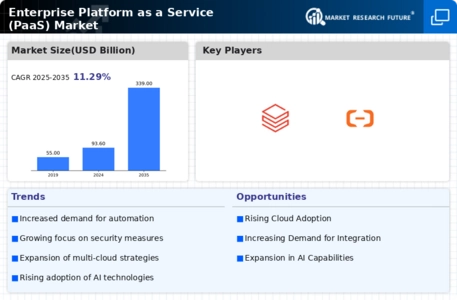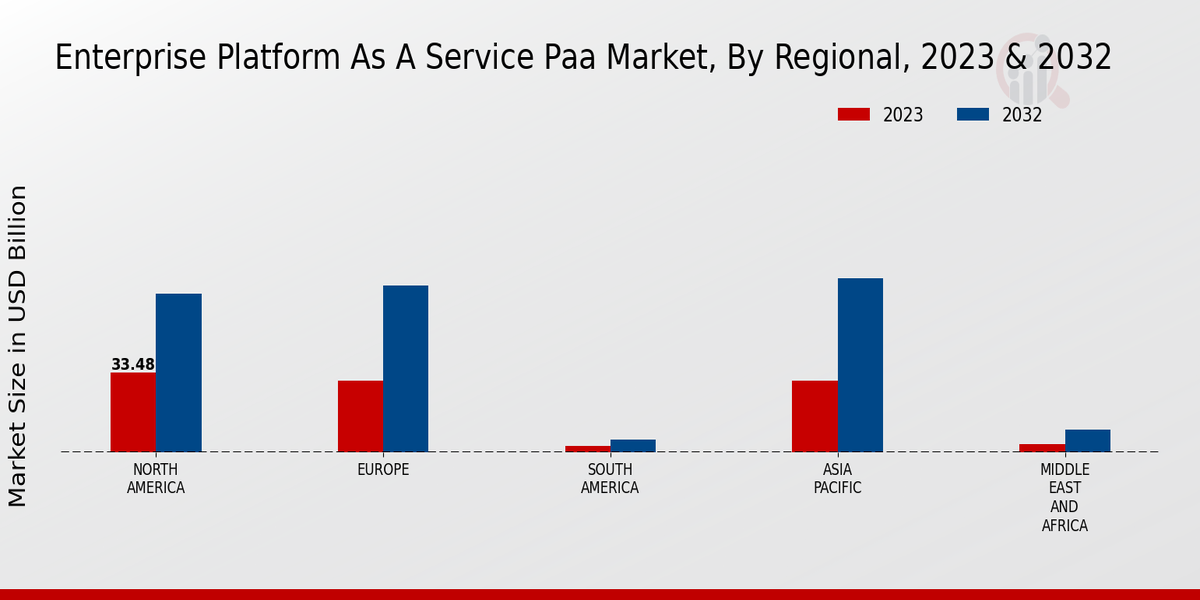Growing Demand for Scalable Solutions
The Enterprise Platform as a Service (PaaS) Market is witnessing a growing demand for scalable solutions as organizations increasingly seek to enhance their operational efficiency. Businesses are transitioning from traditional infrastructure to cloud-based platforms that offer flexibility and scalability. According to recent data, the PaaS market is projected to grow at a compound annual growth rate of over 20% in the coming years. This growth is driven by the need for businesses to quickly adapt to changing market conditions and customer demands. As companies expand their digital capabilities, the ability to scale applications seamlessly becomes paramount. Consequently, PaaS providers are focusing on delivering robust solutions that can accommodate varying workloads, thereby positioning themselves as essential partners in the digital transformation journey.
Enhanced Collaboration and Integration
Enhanced collaboration and integration capabilities are emerging as key drivers in the Enterprise Platform as a Service (PaaS) Market. As organizations increasingly adopt remote work and distributed teams, the need for platforms that facilitate seamless collaboration becomes paramount. PaaS solutions often come equipped with integrated tools that enable teams to work together more effectively, regardless of their physical location. Furthermore, the ability to integrate with existing systems and third-party applications enhances the overall functionality of PaaS platforms. This integration capability is particularly appealing to businesses looking to streamline their operations and improve workflow efficiency. As a result, the demand for PaaS solutions that prioritize collaboration and integration is expected to rise.
Cost Efficiency and Resource Optimization
Cost efficiency remains a pivotal driver in the Enterprise Platform as a Service (PaaS) Market. Organizations are increasingly recognizing the financial benefits of adopting PaaS solutions, which often lead to reduced operational costs. By leveraging PaaS, companies can minimize the expenses associated with maintaining on-premises infrastructure and reduce the need for extensive IT resources. Market analysis indicates that businesses can achieve up to 30% savings in IT costs by migrating to PaaS platforms. This financial incentive is compelling, particularly for small and medium-sized enterprises that may lack the capital for extensive IT investments. As a result, the demand for cost-effective PaaS solutions is likely to continue growing, further propelling the market forward.
Focus on Innovation and Competitive Advantage
The focus on innovation is a driving force in the Enterprise Platform as a Service (PaaS) Market. Organizations are increasingly leveraging PaaS solutions to foster innovation and gain a competitive edge. By utilizing PaaS, businesses can experiment with new ideas and technologies without the constraints of traditional infrastructure. This flexibility allows for the rapid prototyping of applications and services, which can lead to the development of unique offerings that differentiate companies in the marketplace. Market trends indicate that organizations that prioritize innovation through PaaS are more likely to achieve higher growth rates and improved customer satisfaction. As such, the emphasis on innovation is likely to continue shaping the PaaS landscape in the foreseeable future.
Rapid Development and Deployment Capabilities
The Enterprise Platform as a Service (PaaS) Market is significantly influenced by the need for rapid development and deployment capabilities. In an era where speed to market is crucial, organizations are increasingly turning to PaaS solutions that facilitate quicker application development cycles. PaaS platforms provide developers with the tools and environments necessary to build, test, and deploy applications efficiently. Recent statistics suggest that companies utilizing PaaS can reduce their application development time by as much as 50%. This acceleration in development not only enhances productivity but also allows businesses to respond swiftly to market changes and customer needs. Consequently, the emphasis on rapid deployment is likely to drive further adoption of PaaS solutions across various sectors.



 Source: Primary Research, Secondary Research, MRFR Database and Analyst Review
Source: Primary Research, Secondary Research, MRFR Database and Analyst Review













Leave a Comment